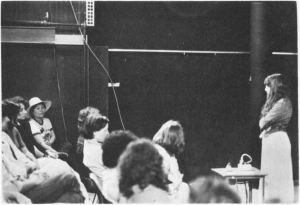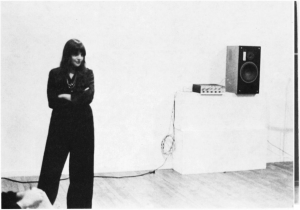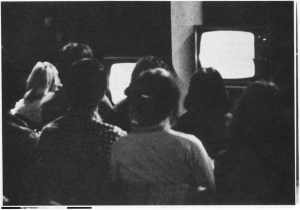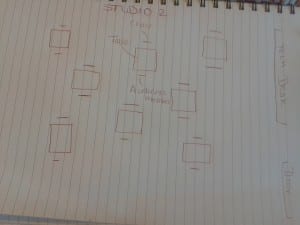The auditorium as a performance space seperates the connection and relationship with the audience as the performance space is bigger and the distance between the performer and audience is greater. However, solo Performances are more intimate as they are usually performed in a smaller space and the distance between the audience and performer decreases. Amy Taubin, is one of many practitioners that questions the relationship between the spectator and performer. Performing solo performance the performer is at the center of attention which instantly changes the dynamic with the relationship. Carroll believes, “The audience’s relationship to the soloist is undivided, gratifying the performer’s deepest desires not only to be seen but to be the center of attention”(Carroll 1979, p. 51). The artist is presenting their desires on stage creates imtimacy between the performer and spectator.
Taubin’s solo career consists of 3 performances; Pimping for Herself (1975), Double Occupancy (1976), and finally Performance Which Began With a Train Ride on Which The Rider Realised But Not Till The Last Moment That She had Been Seated Facing Backwards (1978), all these performances question the relationship between audience and performer. Taubin’s solo performances center around the emphasiation the solo as “representation of self” (Carroll,1979, p.). Also, Taubins performances are preoccupied with being seen. In her performance Pimping Herself, she explores this when she presents enters the performance space. When taubin enters she describes each audience member in the front two rows, making the audience an object of attention. Carroll believes “This gesture could be thought of as the actress’ revenge in so far as it reverses the normal relation between performer and audience”(Carroll 1979, p. 52) Taubin is also reversing the attention from her and putting it purley on the audience. Therefore, questioning who is the performer in this particular section of the performance.

Amy Taubin: The Solo Self, from Noel (1979) p. 53.
As well as exploring the notion of being seen Taubin also contemplates the identity of the female. Taubin’s performance Double Ocupancy explores the female identity. When Taubin enters the space she explains to the audience that she is to enter another room and the audience has the choice to follow her and experience the performance first hand, or to stay in the room and listen to her performance. The text Taubin reads are quotations of Freud that are describing Phallic fantisies. The audience spectator relationship here is different to her previous performance Pimping for Herself, as there are two types of audiences experiencing the same peformance. Taubin is creating a relationship with two sets of audiences.
Double Occupancy:
Amy Taubin: The Solo Self, from Noel (1979) p. 54.
Performance Which Began With a Train Ride… completely changes the dynamic of audience spactator relationship as the audience are light yet the stage itself is completely black, putting all the attention on to the audience. Following this, a camera is set up in the room scans the audience, and presents them on monitors situated at opposite ends of the performance space, again highlighting the audience and making them an object of view but in adifferent form of medium.
Performance Which Began With a Train Ride…:
Amy Taubin: The Solo Self, from Noel (1979) p. 57.
A small element of my final solo performance i want to question the relationship between the audience and the peformer, exploring who is the performer in my particular performance. I intend to do that by having a camera just behind me filming the audience member which will by livestreemed somewhere else in the building. For example, i would like to present their reactions of the private performance and present it on the LPAC TV’s making the private public to anyone who wants to watch. This element of my performance was influenced by Tabin’s Double Occupancy as she had two sets of audience experiencing the same performance but in a different light.
Work Cited
Carroll, Noel (1979) Amy Taubin: The Solo Self in The Drama Review: TDR, 23(1), pp. 51-58.


